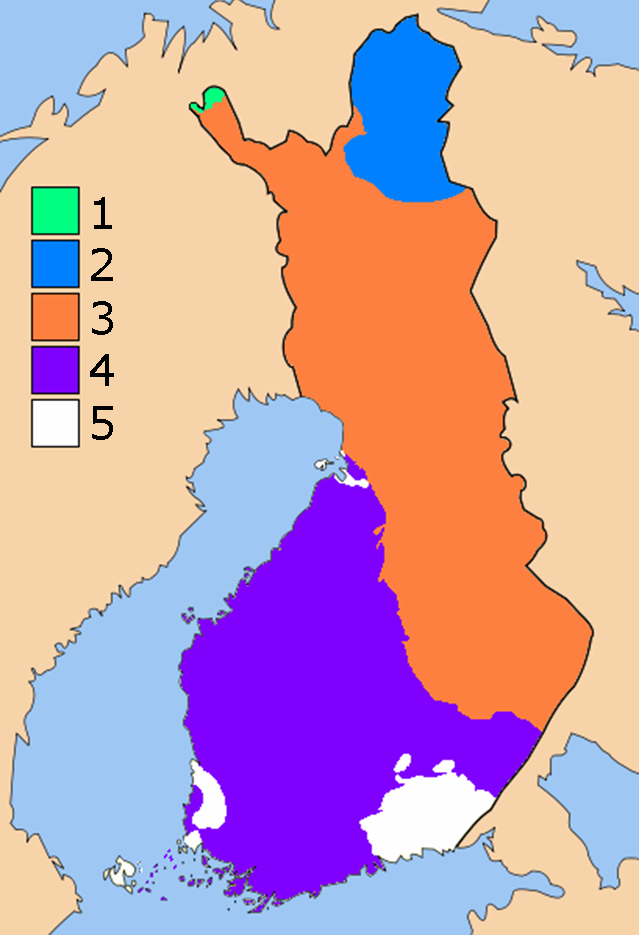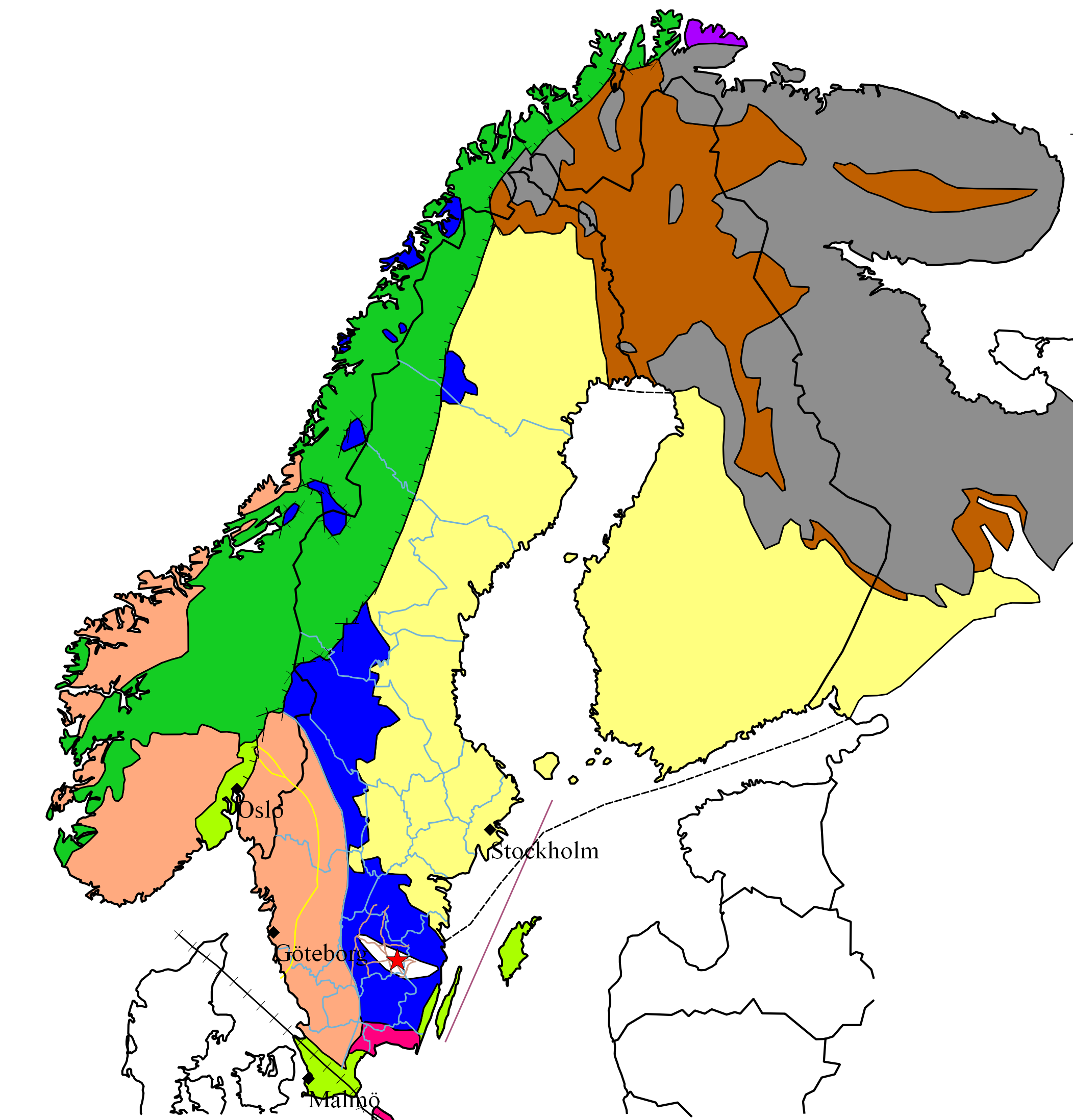|
Fennoscandia
__NOTOC__ Fennoscandia ( Finnish, Swedish and no, Fennoskandia, nocat=1; russian: Фенноскандия, Fennoskandiya) or the Fennoscandian Peninsula is the geographical peninsula in Europe, which includes the Scandinavian and Kola peninsulas, mainland Finland, and Karelia. Administratively this roughly encompasses the mainlands of Finland, Norway and Sweden, as well as Murmansk Oblast, much of the Republic of Karelia, and parts of northern Leningrad Oblast in Russia. Its name comes from the Latin words ''Fennia'' (Finland) and ''Scandia'' (Scandinavian). The term was first used by the Finnish geologist Wilhelm Ramsay in 1898. Geologically, the area is distinct because its bedrock is Archean granite and gneiss with very little limestone Limestone ( calcium carbonate ) is a type of carbonate sedimentary rock which is the main source of the material lime. It is composed mostly of the minerals calcite and aragonite, which are different crystal forms of . Lime ... [...More Info...] [...Related Items...] OR: [Wikipedia] [Google] [Baidu] |
Geology Of Finland
The geology of Finland is made up of a mix of geologically very young and very old materials. Common rock types are orthogneiss, granite, metavolcanics and metasedimentary rocks. On top of these lies a widespread thin layer of unconsolidated deposits formed in connection to the Quaternary ice ages, for example eskers, till and marine clay. The topographic relief is rather subdued because mountain massifs were worn down to a peneplain long ago. Precambrian shield The bedrock of Finland belongs to the Fennoscandian Shield and was formed by a succession of orogenies during the Precambrian. The oldest rocks of Finland, those of Archean age, are found in the east and north. These rocks are chiefly granitoids and migmatitic gneiss. Rocks in central and western Finland originated or were emplaced during the Svecokarelian orogeny. Following this last orogeny rapakivi granites intruded various locations of Finland during the Mesoproterozoic and Neoproterozoic, especially in Åland a ... [...More Info...] [...Related Items...] OR: [Wikipedia] [Google] [Baidu] |
Geology Of Sweden
The geology of Sweden is the regional study of rocks, minerals, tectonics, natural resources and groundwater in the country. The oldest rocks in Sweden date to more than 2.5 billion years ago in the Precambrian. Complex orogeny mountain building events and other tectonic occurrences built up extensive metamorphic crystalline basement rock that often contains valuable metal deposits throughout much of the country. Metamorphism continued into the Paleozoic after the Snowball Earth glaciation as the continent Baltica collided with an island arc and then the continent Laurentia. Sedimentary rocks are most common in southern Sweden with thick sequences from the last 250 million years underlying Malmö and older marine sedimentary rocks forming the surface of Gotland. Stratigraphy, Tectonics & Geologic History The oldest rocks in Sweden date to the Archean, more than 2.5 billion years ago. Archean crystalline basement rocks are restricted to a few areas in the far north and are mainly ... [...More Info...] [...Related Items...] OR: [Wikipedia] [Google] [Baidu] |
Scandinavian Peninsula
The Scandinavian Peninsula ( sv, Skandinaviska halvön; no, Den skandinaviske halvøy (Bokmål) or nn, Den skandinaviske halvøya; fi, Skandinavian niemimaa) is a peninsula located in Northern Europe, which roughly comprises the mainlands of Sweden, Norway and the northwestern area of Finland. The name of the peninsula is derived from the term Scandinavia, the cultural region of Denmark, Norway and Sweden. That cultural name is in turn derived from the name of Scania, the region at the southern extremity of the peninsula which was for centuries a part of Denmark, which is the ancestral home of the Danes, and is now part of Sweden. The Scandinavian Peninsula is the largest of the peninsulas of Europe, with a greater area than the Balkan, Iberian and Italian peninsulas. During the Ice Ages, the sea level of the Atlantic Ocean dropped so much that the Baltic Sea, the Gulf of Bothnia and the Gulf of Finland disappeared, and the countries now surrounding them, includin ... [...More Info...] [...Related Items...] OR: [Wikipedia] [Google] [Baidu] |
Republic Of Karelia
The Republic of Karelia (russian: Респу́блика Каре́лия, Respublika Kareliya; ; krl, Karjalan tašavalta; ; fi, Karjalan tasavalta; vep, Karjalan Tazovaldkund, Ludic: ''Kard’alan tazavald''), also known as just Karelia (russian: Каре́лия, Ка́рьяла; krl, Karjala), is a republic of Russia situated in Northwest Russia. The republic is a part of the Northwestern Federal District, and covers an area of , with a population of 603,067 residents. Its capital is Petrozavodsk. The modern Karelian Republic was founded as an autonomous republic within the Russian SFSR by the Resolution of the Presidium of the All-Russian Central Executive Committee (VTsIK) on 27 June 1923 and by the Decree of the VTsIK and the Council of People's Commissars of 25 July 1923, from the Karelian Labour Commune. From 1940 to 1956, it was known as the Karelo-Finnish Soviet Socialist Republic, one of the union republics in the Soviet Union. In 1956, it was once again ma ... [...More Info...] [...Related Items...] OR: [Wikipedia] [Google] [Baidu] |
Finland
Finland ( fi, Suomi ; sv, Finland ), officially the Republic of Finland (; ), is a Nordic country in Northern Europe. It shares land borders with Sweden to the northwest, Norway to the north, and Russia to the east, with the Gulf of Bothnia to the west and the Gulf of Finland across Estonia to the south. Finland covers an area of with a population of 5.6 million. Helsinki is the capital and largest city, forming a larger metropolitan area with the neighbouring cities of Espoo, Kauniainen, and Vantaa. The vast majority of the population are ethnic Finns. Finnish, alongside Swedish, are the official languages. Swedish is the native language of 5.2% of the population. Finland's climate varies from humid continental in the south to the boreal in the north. The land cover is primarily a boreal forest biome, with more than 180,000 recorded lakes. Finland was first inhabited around 9000 BC after the Last Glacial Period. The Stone Age introduced several different ... [...More Info...] [...Related Items...] OR: [Wikipedia] [Google] [Baidu] |
Nordic Countries
The Nordic countries (also known as the Nordics or ''Norden''; lit. 'the North') are a geographical and cultural region in Northern Europe and the North Atlantic. It includes the sovereign states of Denmark, Finland, Iceland, Norway and Sweden; the autonomous territories of the Faroe Islands and Greenland; and the autonomous region of Åland. The Nordic countries have much in common in their way of life, History of Scandinavia, history, religion and Nordic model, social structure. They have a long history of political unions and other close relations but do not form a singular entity today. The Scandinavism, Scandinavist movement sought to unite Denmark, Norway and Sweden into one country in the 19th century. With the dissolution of the union between Norway and Sweden (Norwegian independence), the independence of Finland in the early 20th century and the 1944 Icelandic constitutional referendum, this movement expanded into the modern organised Nordic cooperation. Since 196 ... [...More Info...] [...Related Items...] OR: [Wikipedia] [Google] [Baidu] |
Wilhelm Ramsay
Wilhelm Ramsay (20 January 1865 – 6 January 1928) was a Finland Swede geologist. He became a member of the Royal Swedish Academy of Sciences in 1914 and in 1915 was accepted into the Royal Physiographic Society in Lund. He coined the terms Fennoscandia (1900) and Postjotnian (1909). Ramsay also coined the term ijolite. Together with Jakob Sederholm, Ramsay was a student of Fredrik Johan Wiik Fredrik Johan Wiik, also known as F.J. Wiik, (16 December 1839 in Helsinki – 15 June 1909 in Helsinki) was a Finnish geologist and mineralogist; in 1877, he was named the first professor of geology and mineralogy at the Imperial Alexander Unive .... Pentti Eskola was a student of Ramsay. References 1865 births 1928 deaths Finnish geologists Tectonicists Members of the Royal Swedish Academy of Sciences Members of the Royal Physiographic Society in Lund Swedish-speaking Finns {{geologist-stub ... [...More Info...] [...Related Items...] OR: [Wikipedia] [Google] [Baidu] |
Northern Europe
The northern region of Europe has several definitions. A restrictive definition may describe Northern Europe as being roughly north of the southern coast of the Baltic Sea, which is about 54°N, or may be based on other geographical factors such as climate and ecology. Climate The climate is mainly Oceanic climate (Cfb), Humid continental climate (Dfb), Subarctic climate (Dfc and Dsc) and Tundra (ET). Geography Northern Europe might be defined roughly to include some or all of the following areas: British Isles, Fennoscandia, the peninsula of Jutland, the Baltic plain that lies to the east and the many islands that lie offshore from mainland Northern Europe and the main European continent. In some cases, Greenland is also included, although it is only politically European, comprising part of the Kingdom of Denmark, and not considered to be geographically in Europe. The area is partly mountainous, including the northern volcanic islands of Iceland and Jan Mayen, and ... [...More Info...] [...Related Items...] OR: [Wikipedia] [Google] [Baidu] |
Peninsula
A peninsula (; ) is a landform that extends from a mainland and is surrounded by water on most, but not all of its borders. A peninsula is also sometimes defined as a piece of land bordered by water on three of its sides. Peninsulas exist on all continents. The size of a peninsula can range from tiny to very large. The largest peninsula in the world is the Arabian Peninsula. Peninsulas form due to a variety of causes. Etymology Peninsula derives , which is translated as 'peninsula'. itself was derived , or together, 'almost an island'. The word entered English in the 16th century. Definitions A peninsula is usually defined as a piece of land surrounded on most, but not all sides, but is sometimes instead defined as a piece of land bordered by water on three of its sides. A peninsula may be bordered by more than one body of water, and the body of water does not have to be an ocean or a sea. A piece of land on a very tight river bend or one between two rivers is sometimes ... [...More Info...] [...Related Items...] OR: [Wikipedia] [Google] [Baidu] |
Kola Peninsula
sjd, Куэлнэгк нёа̄ррк , image_name= Kola peninsula.png , image_caption= Kola Peninsula as a part of Murmansk Oblast , image_size= 300px , image_alt= , map_image= Murmansk in Russia.svg , map_caption = Location of Murmansk Oblast within Russia , location= Northwest Russia , coordinates= , area_km2= 100000 , length_km= 370 , width_km= 244 , highest_mount= Yudychvumchorr , elevation_m= 1201 , waterbody = * Barents Sea * White Sea , country= Russia , country_admin_divisions_title= Oblast , country_admin_divisions= Murmansk Oblast , density_km2= , demonym= , population= , citizenships= The Kola Peninsula (russian: Кольский полуостров, Kolsky poluostrov; sjd, Куэлнэгк нёа̄ррк) is a peninsula in the extreme northwest of Russia, and one of the largest peninsulas of Europe. Constituting the bulk of the territory of Murmansk Oblast, it lies almost completely inside the Arctic Circle and is bordered by the Barents Sea to the nort ... [...More Info...] [...Related Items...] OR: [Wikipedia] [Google] [Baidu] |
Finnish Language
Finnish (endonym: or ) is a Uralic language of the Finnic branch, spoken by the majority of the population in Finland and by ethnic Finns outside of Finland. Finnish is one of the two official languages of Finland (the other being Swedish). In Sweden, both Finnish and Meänkieli (which has significant mutual intelligibility with Finnish) are official minority languages. The Kven language, which like Meänkieli is mutually intelligible with Finnish, is spoken in the Norwegian county Troms og Finnmark by a minority group of Finnish descent. Finnish is typologically agglutinative and uses almost exclusively suffixal affixation. Nouns, adjectives, pronouns, numerals and verbs are inflected depending on their role in the sentence. Sentences are normally formed with subject–verb–object word order, although the extensive use of inflection allows them to be ordered differently. Word order variations are often reserved for differences in information structure. ... [...More Info...] [...Related Items...] OR: [Wikipedia] [Google] [Baidu] |






